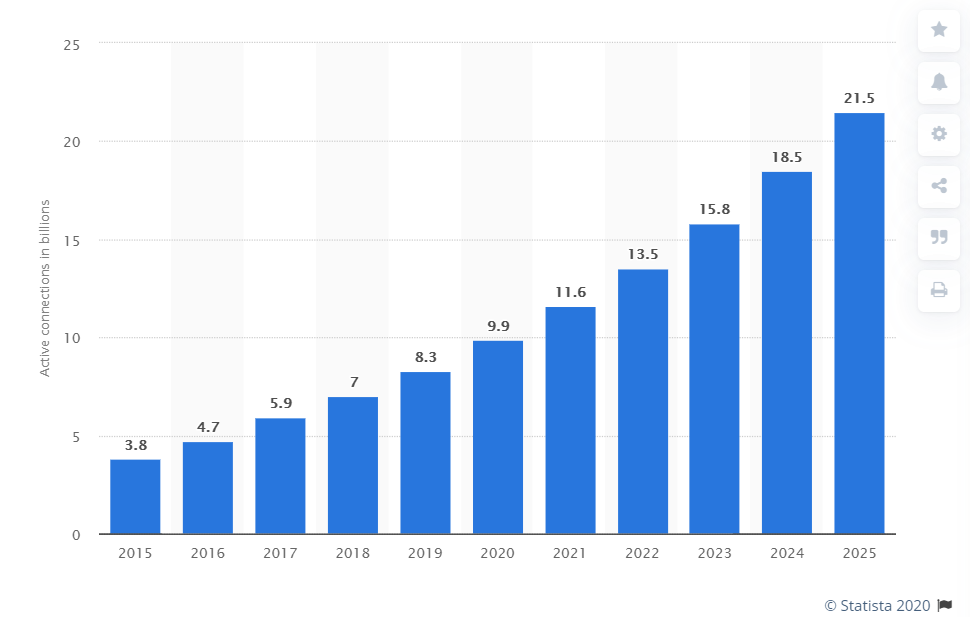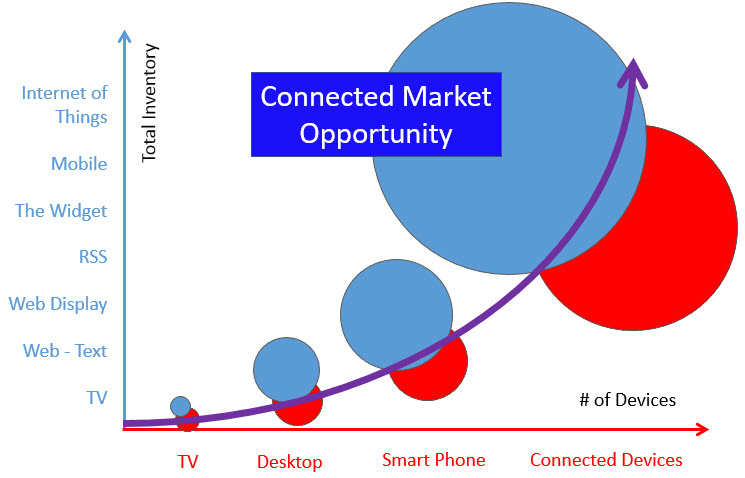The world will be running on machines soon. Machines will make your coffee for you. Machines will pick up your laundry up. Machines will teach your children. People will still have a role. But machines will run the show. And the machines will all be connected. Full stop.
So we get it, machines are going to be a bigger deal. I’ll leave it to the ethicists, politician and clergy to give / tell us the bigger meaning (although I reserve the right to soap box this subject down the road). For the marketer, IoT marketing will be a game changer and one that we all better start preparing for today.
Think about it.
IoT Sizing
Statista estimates there will be 21.5 billion connected devices by 2025; currently there are an estimated humans 7.8 billion roaming the world.

Internet of Things – active connections worldwide 2015-2025
Published by Statista Research Department, Mar 3, 2020
The total installed base of Internet of Things (IoT) connected devices is projected to amount to 21.5 billion units worldwide by 2025. Included in this number are active nodes/devices or gateways that concentrate the end-sensors, rather than consumer devices such as computers and cellphones.
Internet of Things (IoT) active device connections installed base worldwide from 2015 to 2025. Source: https://www.statista.com/statistics/1101442/iot-number-of-connected-devices-worldwide/
The numbers are compelling.
IoT Opportunity
Moving beyond the pure numbers (people and things), let’s start to size the opportunity. To help contextualize around the opportunity, a few years back I wrote an article, Connected Marketing, that started to probe around size, scope and timing.
 A Things Strategy?
A Things Strategy?
So far we’ve defined the overall size, and hopefully you are beginning to appreciate the opportunity.
The question I’d like to ask is do you have a “thing strategy”? And related to your thing strategy which should encompass your entire organization, do you have thing marketing strategy? And yes, I am one of those marketers that believes marketing should own the “go to market” AND the “what’s the market” pieces of a business.
IoT Marketing Landscape
So let’s crystal ball and explore how with more Things, IoT marketing will be forced to evolve. Marketers are going to have to re-examine what we do and what we deliver back to our organizations.
SEO and iSEO: Think about it. With so many Things in play, how are they going to find one another? Yes, at first it will likely be something akin to a list server with a very limited menu. But as Things get smarter they’ll want (and need) to know more of their neighbors. As Things get even smarter they want (and need) to know what people are interested in.
So yes, at some point there will be Things that are searching for so many solutions to Thing specific challenges. And it is a safe bet that there will be some kind of IoT search engine. At that moment iSEO will be born. And as happens with the people version of search, there will be a need for marketers to help their organizations (and their Things) win in search.
You didn’t really think SEO would loosen its grip so easily, did you?
Things Analytics, or AoT: Think about it? Do you know how your Things work today? How they are used, and at what intervals and frequency? Even today, your Things probably can perform multiple functions – which ones are used and which ones are not? According to an AoT article from Deloitte, the time to start building your AoT strategy is now! And guess what, this is something that marketing should be influencing. As AoT matures this will be a Things function that marketing will own.
People Analytics: More about the study of behavior – what people do, and the meaning behind their actions. Think about it…
A guy walks into a room.
In the world of connected things there is likely a sensor that will trigger a few different actions. It will turn the lights on. It might adjust the temperature, depending on the time of day it could change the window tint, or possibly even the angle of the house. If the sensor has a connected camera it might even greet the man by name. Based on past activities of this guy it might warm up the car. Fire up some screens (could be informational, or perhaps for entertainment.) Possibly a Thing might even start cooking up a meal….
Now imagine this happening across 7.8 billion people’s morning. Now imagine this same experience extending to 24 hours a day. People analytics will be a game changer. And you as a marketer better ensure your message is there instead of that of your competitors. How those screens sequence will matter. How those Thing APIs get called will determine which thing scores and which Thing has to circle the block for a new opportunity.
Paid Media: Going back to the opportunity chart I shared above, as the number of devices starts to far outpace the number of people, the amount of marketing opportunities will also grow. Available advertising inventory will dramatically expand. Clicks will have more and more opportunity to be hyper relevant, hyper timely and hyper competitive within very specific moments. Many of your paid activities will be based on what a specific person is doing as a very specific moment in time in a specific location.
Now, in addition to applying this specific moment and specific location concept to people, multiply this effort as it will also apply to Things! Yes, you’ll be able to bid on Thing actions, and Things will likely actively solicit competition from both other Things and other people. With Things in the mix the marketplace of opportunity will expand across multiple horizons. And not to mention… Things will also be doing some of the ad bidding….
Another idea to consider will be what “cross screening” looks like in a Things friendly world. So many screens and so many different inflection points. Consider if you wanted to market to a specific target audience within a timeline. Remember that guy that walked into a room… now let’s imagine marketing to him throughout a long weekend. How many screens would he encounter over 72 hours, and how would you as a marketer maximize the cross screening experience to help produce an outcome?
While the paid media activities of today are already complex, are you as a marketer in any way prepared for Things to enter the game?
Sales Funnel: Whether you are B2B or B2C when Things mature your sales funnel will not look the same. You’ll have more opportunity, but competition will also look different. With the abundance of available marketing inventory, combined with strong predictive people and Things analytics (AoI) this space will require you as a marketer to develop new skill sets. Your CRM could easily become a data warehouse. The customer journey will utilize entirely new narratives. Customer lifetime value (CLV) will also look considerably different, again assuming you are able to maintain an ongoing datastream with your customers.
Services: One area closely related to the sales funnel that I’d like to call out is the whole concept of services in a Things friendly world. Idle Things will be out there aggressively hawking their services (cleaning, delivery, repair) while other Things (or Thing of Things systems) will be actively running and in real time requiring services in order to continue to run. The value is here, but the market will be an interesting one. Marketers, get ready.
Cross Selling: Also related to your sales funnel will be cross selling, both within your own stack (what you selling) and through alliances. As an organization, once you acquire the first party data through a customer using one of your Things, ostensibly you’ll have an advantage in terms of moving that customer to continue to utilize more of the original Thing, or perhaps new Things or related services. Marketing will have a big role to play in this arena. Smart companies are looking to leverage this concept now (along with customer retention), and in a Things friendly world cross selling will take on more urgency as well as new dimension.
Customization: In today’s world “Content is King.” Tomorrow “Customization will rule the roost.” We are already seeing manufacturers move from “mass production to mass customization.” As Things get more and more connected, and more intertwined with the people they support (people analytics) and as Things have both hardware and software running through them it is safe to say each Thing will become more synchronized to the specific person at the specific moment in a specific location.
As Things develop more customization, naturally this individualized customization will also begin to creep into the baseline product offerings. Product development, meet marketing. Marketing, meet product development. Again, this will impact both B2B and B2C. Customization will offer a ton on opportunity, but it will also introduce exponential complexity. Buckle up as this will be a big one.
Cross Thing Tracking: The last piece of landscape we’ll explore for now is around cross thing tracking. Currently in marketing the challenge is really limited to cross device tracking, essentially tracking a person across multiple devices that they own or use as primary connectivity outlets (basically all the connected devices not included in the above Statista IoT chart). Cross device tracking is a bit of a holy grail topic for today’s marketer. Through it we can unlock all kinds of user data (particularly through your mobile phone that travels with you, virtually everywhere you go.) Social media has also unlocked considerable insight around this area as social provides adds a layer of context that previously was hidden. But cross domain tracking has also unleashed a Pandora’s Box around privacy – and rightly so.
Now imagine multiplying that complexity by attempting to the journey of the guy who woke up. Sure in his house it seems like a reasonable endeavor. But once he leave the four walls that we can best control, and he is even casually coming into contact with so many other things, we still want to map his journey. We still want to market across his journey. We still want to bid and analyze across this expansive horizon. By the way, many of these things are moving. And to take it even further, let’s assume we want to do the same thing not just for all the people, but also to posses cross thing tracking for all the Things. As you can see, all these items are connected and interwoven. And oh yeah… there is still the privacy issue.
As a marketer, your understanding of cross domain tracking (as well as your application of this concept) will eventually evolve into how you can or cannot leverage cross thing tracking. If you aren’t already doing so, now would be a good time to develop some strength in this space.
Managing IoT Marketing Ambiguity
While I don’t want to come up like some crystal ball charlatan, I am comfortable with the above. I get that it might not play out exactly like I’ve outlined, but I also I’ve spent a good deal of time exploring the IoT space, and more than a good deal of time around digital marketing.
So with than in mind as a closing element to this piece I’d like to point you to How to Do Strategic Planning Like a Futurist by Amy Webb (via Harvard Business Review, so a subscription may be required.) This futurist planning framework could provide a good canvas for which to begin to build out your Thing strategy…

using a cone timeline instead of a linear line to help embrace ambiguity
IoT Marketing Wrap Up (for now)
I’ll keep it short. Your takeaway as a marketer is that now is the time to start developing your thing strategy.


